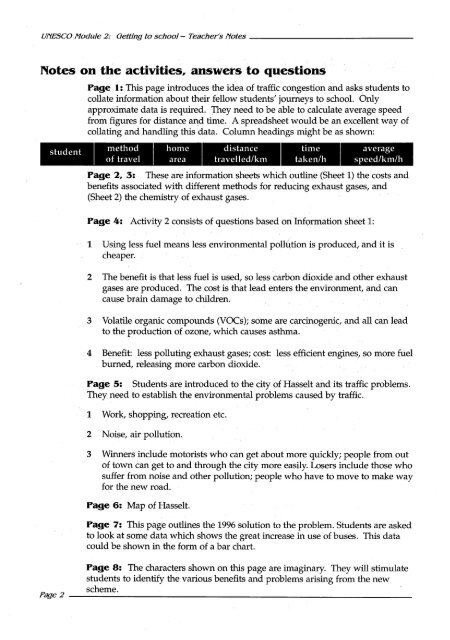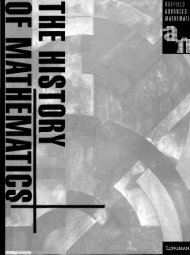UNESCO resource kit - science and technology educa...
UNESCO resource kit - science and technology educa...
UNESCO resource kit - science and technology educa...
Create successful ePaper yourself
Turn your PDF publications into a flip-book with our unique Google optimized e-Paper software.
<strong>UNESCO</strong>Module 2: Oettinq to school- Teacher's Noles _<br />
Notes on the activities, answers to' questions<br />
Page I: This page introduces the idea of traffic congestion <strong>and</strong> asks students to<br />
collate information about their fellow students' journeys to school. Only<br />
approximate data is required. They need to be able to calculate average speed<br />
from figures for distance <strong>and</strong> time. Aspreadsheet would be an excellent way of<br />
collating <strong>and</strong> h<strong>and</strong>ling this data. Column headings might be as shown:<br />
student method home<br />
of travel area<br />
distance<br />
travelled/km<br />
time<br />
taken/h<br />
average<br />
speed/km/h<br />
Page 2, 3: These are information sheets which outline (Sheet 1) the costs <strong>and</strong><br />
benefits associated with different methods for reducing exhaust gases, <strong>and</strong><br />
(Sheet 2) the chemistry of exhaust gases.<br />
Page 4: Activity 2 consists of questions based on Information sheet 1:<br />
1 Using less fuel means less environmental pollution is produced, <strong>and</strong> it is<br />
cheaper.<br />
2 The benefit is that less fuel is used, so less carbon dioxide <strong>and</strong> other exhaust<br />
gases are produced. The cost is that lead enters the environment, <strong>and</strong> can<br />
cause brain damage to children.<br />
3 Volatile organic compounds (VOCs); some are carcinogenic, <strong>and</strong> all can lead<br />
to the production of ozone, which causes asthma. .<br />
4 Benefit: less polluting exhaust gases; cost: less efficient engines, so more fuel<br />
burned, releasing more carbon dioxide.<br />
Page 5: Students. are introduced to the city of Hasselt <strong>and</strong> its traffic problems.<br />
They need to establish the environmental problems caused by traffic.<br />
1 Work, s~opping, recreation etc.<br />
2 Noise, air pollution.<br />
3 Winners include motorists who can get about more quickly; people from out<br />
of town can get to <strong>and</strong> through the city more easily.Losersinclude those who<br />
suffer from noise <strong>and</strong> other pollution; people who have to moveto make way<br />
for the new road.<br />
Page 6: Map of Hasselt.<br />
Page 7: This page outlines the 1996 solution to the problem. Students are asked<br />
to look at some data which shows the great increase in use of buses. This data<br />
could be shown in the form of a bar chart.<br />
Page 8: The characters shown on this page are imaginary. They will stimulate<br />
students to identify the various benefits <strong>and</strong> problems arising from the new<br />
scheme.<br />
Page2 ------ __ ~-------~-------~-----------

















